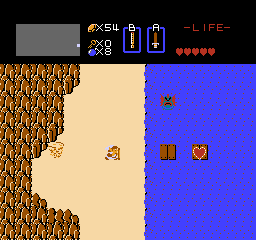The Legend of Zelda
| The Legend of Zelda |
|---|
|
Também conhecido como: Zelda no Densetsu: The Hyrule Fantasy (JP, FDS)
|
The Legend of Zelda apresenta Link em uma jornada para salvar Zelda do malvado Gannon (sic!). Em seu caminho, ele não pega nenhuma ajuda, exceto pelo Velho que dá a ele um palito aleatório que ele apanhou em algum lugar (mais umas vagas dicas), e está por si só na vasta terra de Hyrule.
Contents
Subpáginas
| Diferenças de Console Porque nem todo mundo tem um Famicom Disk System. Alguns têm um Game Boy Advance. |
Unused Enemy Type
Enemy type $42 is a Gleeok with one head, unused in the final game. This can be seen by freezing RAM address $0350 at $42 and changing screens.
Texto Inutilizado
クワシイコトハ マニュアルヲ ヨミマショウ
Em ambas as versões de cartucho do FDS e Famicom, essa peça de texto inutilizada é encontrada no fim da listagem de tesouros. Ela servia o mesmo propósito e diz basicamente a mesma coisa que a placa que Link está segurando no jogo finalizado.
Diferenças Revisionais
| To do: Outras diferenças? |
Heart Container Glitch
In the original FDS release (v1.0), there is a glitch that allows players to easily get a lot of extra Heart Containers: on the eastern shoreline, there's a Heart Container that is normally only reachable with the Ladder. However, if you use the Flute while standing in the same row as it you'll pick up the Heart Container when the whirlwind drags you across the screen, and the Heart Container will still be there when you return.
The number of dungeons you've completed seems to determine how many times you can do this, so if you've only completed two dungeons, you can only do this twice. The number of Heart Containers will still max out at 16, and you can't get any more than that. This trick is perhaps most effective in the much harder Second Quest, where you obtain the Flute in Level 2. Using this trick makes the Second Quest much easier not only because of increased life, but the quicker you increase the number of hearts you have the quicker you can obtain the stronger swords.
Esse glitch foi consertado em v1.1.
Tela de Título
| PRG0 | PRG1 |
|---|---|
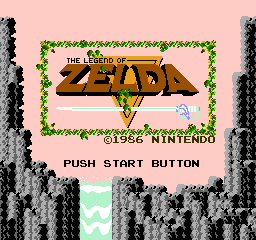 |
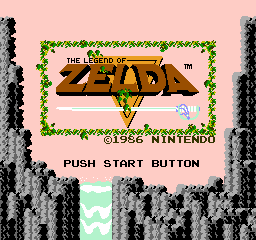 |
A versão PRG1 adiciona um símbolo de marca registrada à tela de título.
Tela de Opções de Salvar
| PRG0 | PRG1 | Animal Crossing |
|---|---|---|
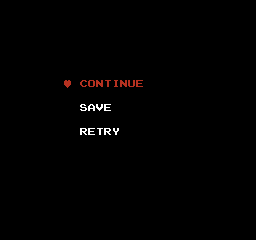
|
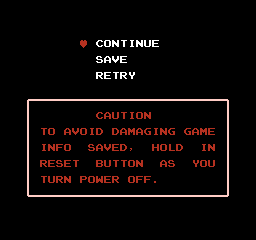
|
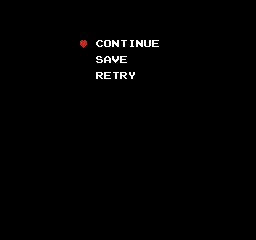
|
A versão PRG1 adiciona um pequeno aviso para a tela de Continuar/Salvar/Recomeçar. A versão elusiva de Animal Crossing do jogo mantêm essa disposição de tela mas remove o aviso, já que é desnecessário no GameCube. Vale a pena notar que The Legend of Zelda é um de só dois jogos (o outro sendo Super Mario Bros.) que são completamente inobtíveis em Animal Crossing sem um dispositivo de jogo como Action Replay.
Algumas versões de Virtual Console usam essa disposição de tela também.
Transições de Tela
O re-lançamento de cartucho do Famicom tem transições de tela mais suaves comparado com as versões de FDS e NES. Quando você entra ou sai de uma caverna nas versões FDS e NES, a imagem pisca brevemente; isso foi consertado no re-lançamento do Famicom.
Localização Inglesa
Algumas das dicas foram mudadas ao invés de traduzidas para a localização em Inglês. O Ingrêis severo e motivo esquisito por trás de algumas das mudanças não deixa claro o que a Nintendo tinha em mente para algumas das mudanças feitas.
Level 1
| Japanese | English |
|---|---|
| オカネガナクナレバ ヤ ハ ツカエナイ |
EASTMOST PENNINSULA IS THE SECRET. |
Literal translation: "You can't use arrows if you run out of money."
The hint in the Japanese version is a useful tip on how the Bow works, which you get in this dungeon. In the English version, it was changed to a hint for a secret 100 Rupee location.
Level 5
| Japanese | English |
|---|---|
| オトニヨワイ イキモノ ガイル |
SECRET POWER IS SAID TO BE IN THE ARROW. |
Literal translation: "There are some creatures that are weak against sound."
The hint in the Japanese version refers to the Pols Voice's weakness. Since the Famicom microphone controller was never released outside of Japan, the method to defeat Pols Voice was changed and the text change reflects this.
Level 7
| Japanese | English |
|---|---|
| メガネイワ ハ シヘノ イリグチ |
THERE'S A SECRET IN THE TIP OF THE NOSE. |
Literal translation: "Spectacle Rock is an entrance to death."
The hint for how to find Level 9 was for some reason moved to Level 8 (see below). "The tip of the nose" is apparently the room in Level 7 where a secret path to the boss' lair is found. A very odd choice...
Level 8
| Japanese | English |
|---|---|
| デスマウンテンデ ヤヲ サガセ |
SPECTACLE ROCK IS AN ENTRANCE TO DEATH. |
Literal translation: "Look for the arrows in Death Mountain."
The English version's hint was moved from Level 7 and in the process replaced the hint for where to find the Silver Arrows. What?!
| Japanese | English |
|---|---|
| ライオンノカギヲサガセ | 10TH ENEMY HAS THE BOMB. |
Literal translation: "Search for the Lion Key."
The hint that you should look for the Magical Key in Level 8 (aka Lion) was replaced with... not the most helpful of hints.
(The English line may be an attempt to hint that if you defeat ten enemies without getting hit and defeat the 10th one with a bomb, said enemy will drop a set of four bombs. If you defeat the 10th enemy with the sword, it will give you a blue Rupee instead.)
Level 9
| Japanese | English |
|---|---|
| アカイユビワヲ ミツケ タカイ |
EYES OF SKULL HAS A SECRET. |
Literal translation: "Have you found the Red Ring?"
The reminder that you should probably find the Red Ring was changed to a hint for how to find the Compass.
| Japanese | English |
|---|---|
| イチバンウエ ノ サカ イメヲ コワセ |
PATRA HAS THE MAP. |
Literal translation: "Destroy the topmost boundary."
The Japanese line may be a hint for how to find the Red Ring, but it's really vague and could as well refer to something else. Maybe that's the reason it was ultimately replaced in the English version?
(What's odd is that this hint was already in place in the prototype version of the game, where all the items in Level 9 were still in different locations.)
Level 6, Second Quest
| Japanese | English |
|---|---|
| ミズウミノ キタ ニハ ヒミツガ アル |
SOUTH OF ARROW MARK HIDES A SECRET. |
Literal translation: "There’s a secret north of a lake." Another really vague hint in the Japanese original that was replaced with something that made more sense - in this case, a hint for finding Level 8.
Cleanup > Pages missing date references
Cleanup > Pages missing developer references
Cleanup > Pages missing publisher references
Cleanup > To do
Games > Games by content > Games with regional differences
Games > Games by content > Games with revisional differences
Games > Games by content > Games with unused enemies
Games > Games by developer > Games developed by Nintendo
Games > Games by publisher > Games published by Nintendo
Games > Games by series > Legend of Zelda series
